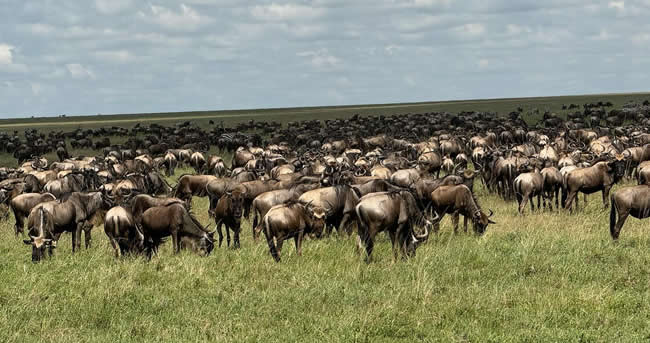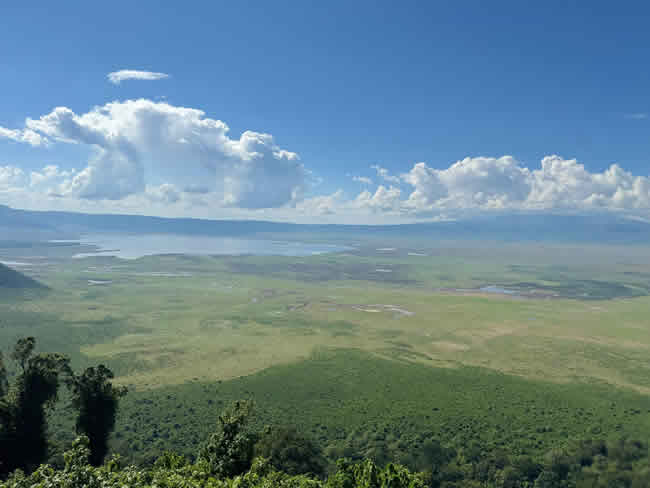Introduction
The raw beauty of Africa’s wilderness can be witnessed by the Serengeti National Park, which is tucked away deep within Tanzania. Known for its beautiful landscape, varied fauna, and historic ecosystems, this well-known park covers an area of more than 14,750 square kilometers. Adventurers and activists find the Serengeti to be incredibly attractive, with its wide plains interlaced with acacia trees, stunning kopjes, and bending rivers. In this piece, we explore the amazing details that contribute to the Serengeti National Park’s status as a biodiversity treasure and a wildlife lover’s paradise.
The Great Migration, one of the most amazing animal exhibitions on Earth, is closely linked to Serengeti National Park. A magnificent display of movement and survival is produced every year when millions of wildebeest, zebra, and gazelles cross the plains in search of better pastures. This magnificent migration serves as a powerful example of the adaptability of Africa’s fauna as well as the interdependence of all the species in the Serengeti ecosystem. The park offers visitors unique chances for animal viewing and photography because it is home to a multitude of other iconic species, such as lions, elephants, giraffes, and cheetahs, in addition to the migratory herds.

Beneath the endless skies of Serengeti National Park is a geological variety shaped by millions of years of natural processes. From the ancient volcanic formations of the Gol Mountains to the beautiful Maasai kopjes, the park’s landscapes offer a look into the erratic past of the planet. The Ngorongoro Crater, a massive caldera teeming with wildlife and surrounded by steep walls that act as a natural enclosure for its inhabitants, is one of the park’s most iconic features. These varied landscapes combine to create a sanctuary for an extensive number of species while also adding to the park’s unbeatable beautiful scenery.

Serengeti National Park is one of the most famous protected areas in the world and a UNESCO World Heritage Site, but it also faces many conservation challenges. Poaching, habitat degradation, and conflict between humans and wildlife are some of the ongoing threats to the park’s fragile ecosystems and the species that call it home. Nevertheless, thanks to the tireless efforts of conservation organizations, local communities, and park rangers, great progress has been made in preserving the park’s natural heritage. Conservationists are working to ensure that future generations can enjoy the wonders of Serengeti National Park.
Facts about Serengeti National Park
- The Great Migration, the world’s greatest terrestrial mammal migration, takes place in the Serengeti National Park. Each year, hundreds of thousands of zebras and gazelles, as well as about 1.5 million wildebeest, travel throughout the Serengeti ecosystem in quest of new grazing areas. This remarkable trip, which spans around 800 kilometers, highlights the animals of Africa’s extraordinary adaptation and persistence.
- In 1981, Serengeti National Park received the UNESCO World Heritage Site designation. This esteemed designation recognizes the park’s remarkable biodiversity, ecological importance, and cultural legacy, guaranteeing its preservation for the enjoyment and amazement of future generations.
- All five of the famous Big Five, lions, elephants, leopards, rhinoceroses, and African buffaloes can be found in the Serengeti National Park. These famous animals are among the most sought-after sightings for visitors exploring the park’s expansive woods and savannas. They symbolize the highest levels of African wildlife.
- The environment of the Serengeti was crucial in forming our knowledge of evolutionary biology. Modern conservation science has its roots in this area, where scientists like Bernhard Grzimek and George Schaller conducted innovative research that shed light on animal behavior, population dynamics, and predator-prey relationships.
- The vast grasslands of the Serengeti, which stretch forever into the distance, are widely associated with the African wilderness. These vast grasslands, which are characterized by short grasses and occasional acacia trees, provide the main habitat for the park’s resident herbivores and support a complicated web of life that keeps numbers of both predators and prey.
- The Serengeti National Park is a wonderland for naturalists and photographers hoping to get up close and personal with lions, cheetahs, leopards, and hyenas because it has one of the greatest densities of predators in Africa. These apex predators find great hunting grounds in the park’s varied landscapes, which also present plenty of chances to see the African savanna’s dynamic opening.
- Encased in undiscovered resources that date back thousands of years are the granite outcrops of the Serengeti. Old rock art sites, like those in the Moru Kopjes, provide insights into the cultural legacy of the area’s first residents. These sites show depictions of hunting, rituals, and everyday life that were cut into the stone by ancient hands.
- Birdwatchers and ornithologists will find the afterlife in Serengeti National Park, which has over 500 bird species reported inside its borders. The park’s varied birds highlight the great biodiversity of East Africa’s skies, with majestic raptors flying overhead and colorful songbirds darting among the branches.
- A wonderful sight occurs every year when millions of ungulates cross rivers teeming with crocodiles and starving predators in a never-ending search for survival. This is the wildebeest migration. For those who love wildlife, seeing this incredible event up close is a once-in-a-lifetime opportunity that will deepen their understanding of the resiliency and persistence of Africa’s animal kingdom.
- George Schaller launched the Serengeti Lion Project in the 1960s, and it is still one of the longest-running studies of large carnivores in the wild. Researchers have contributed to ongoing efforts to protect these magnificent predators by gaining unique insights into the behavior, ecology, and conservation needs of the iconic lion population of the Serengeti via decades of careful fieldwork and scientific observation.
- The Great Wildebeest The calving process is another amazing natural event that takes place on the southern grasslands of Serengeti National Park every year from January to March. Predators and photographers alike are drawn to the grasslands as hundreds of thousands of expectant wildebeest congregate to give birth simultaneously, bringing with them the sights and sounds of new life.
- For thousands of years, human cultures have lived in the Serengeti ecosystem, leaving their cultural legacies, ancestors’ knowledge, and archeological sites as evidence of their presence. The Maasai people still have a strong spiritual bond with the land and its inhabitants, and they live together with the local wildlife today.
Conclusion
The wonders of Serengeti National Park serve as a constant reminder of the interdependence of all life on Earth and the value of conservation in preserving it for future generations. The vast expanses of the Serengeti captivate the hearts and imaginations of anyone who travels through it, whether it is through the distant roar of a lion on the plains or the silent beauty of a baobab tree against the African sky. The Serengeti is a timeless symbol of Africa’s wild beauty and the ongoing heritage of our planet’s natural valuables. By continuing to support conservation initiatives and sustainable tourism practices, we can ensure that Serengeti remains a light of hope and inspiration for centuries to come.
